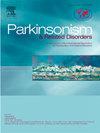FGF14 (GAA∙TTC) repeat expansion-related ataxia SCA27B is common in Northern Finland
IF 3.1
3区 医学
Q2 CLINICAL NEUROLOGY
引用次数: 0
Abstract
Introduction
An intronic repeat expansion (GAA∙TTC)exp in the FGF14 gene (FGF14 (GAA∙TTC)exp) has recently been found to cause dominantly inherited ataxia SCA27B. The core phenotype consists of late-onset and slowly progressing ataxia with down-beat nystagmus and episodic features. Disease penetrance depends on the number of repeat units and ≥300 is widely used pathogenic threshold for complete penetrance. The Finnish population is genetically unique and SCA27B has not previously been reported in Finland.
Methods
We investigated FGF14 (GAA∙TTC)exp in a cohort of 96 Finnish patients with suspected hereditary ataxia or ataxia of unknown etiology, of whom 62 patients had no previous genetic diagnosis. We also assessed FGF14 (GAA∙TTC)exp in 561 controls in order to estimate its population prevalence in North Ostrobothnia.
Results
We found five patients with FGF14 (GAA∙TTC)≥250 giving a frequency of 5.2 % in the ataxia cohort. One patient had a rare biallelic genotype. Four patients had the classical SCA27B phenotype with no atypical features. Two of the patients had a previous genetic diagnosis and digenic contribution could not be excluded. Moreover, we found one patient with suspected FGF14 disease and with (GAA∙TTC)248, but the segregation analysis remained inconclusive. The (GAA∙TTC)≥250 frequency was 2.7 % in the general population. Population prevalence was 1.7 per 100 000 in North Ostrobothnia. The frequency of alleles harboring 200–249 repeats was 2.2 % in patients and 1.5 % in controls.
Conclusion
Our results suggest that screening of FGF14 expansion should be carried out in Finnish patients with suspected hereditary ataxia or ataxia of unknown etiology.
FGF14 (GAA∙TTC)重复扩张相关共济失调SCA27B在芬兰北部很常见
FGF14基因中的内含子重复扩增(GAA∙TTC)基因(FGF14 (GAA∙TTC)基因)最近被发现导致显性遗传性共济失调SCA27B。核心表型包括迟发性和缓慢进展的共济失调,伴有低节拍眼球震颤和发作性特征。疾病外显率取决于重复单位的数量,≥300是广泛使用的完全外显率的病原阈值。芬兰人在遗传上是独特的,以前在芬兰没有报道过SCA27B。方法对96例芬兰疑似遗传性共济失调或病因不明的共济失调患者的FGF14 (GAA∙TTC)基因表达进行研究,其中62例患者既往无遗传诊断。我们还在561例对照中评估了FGF14 (GAA∙TTC)exp,以估计其在北Ostrobothnia的人群患病率。结果我们发现5例患者FGF14 (GAA∙TTC)≥250,在共济失调队列中出现频率为5.2%。一名患者患有罕见的双等位基因型。4例患者为典型的SCA27B表型,无非典型特征。其中两名患者先前有遗传诊断,不能排除遗传因素的影响。此外,我们发现1例疑似FGF14疾病和(GAA∙TTC)248的患者,但分离分析仍不确定。一般人群中(GAA∙TTC)≥250的发生率为2.7%。人口患病率为每10万人1.7人。200-249次重复的等位基因频率在患者中为2.2%,在对照组中为1.5%。结论芬兰疑似遗传性共济失调或病因不明的共济失调患者应进行FGF14扩增筛查。
本文章由计算机程序翻译,如有差异,请以英文原文为准。
求助全文
约1分钟内获得全文
求助全文
来源期刊

Parkinsonism & related disorders
医学-临床神经学
CiteScore
6.20
自引率
4.90%
发文量
292
审稿时长
39 days
期刊介绍:
Parkinsonism & Related Disorders publishes the results of basic and clinical research contributing to the understanding, diagnosis and treatment of all neurodegenerative syndromes in which Parkinsonism, Essential Tremor or related movement disorders may be a feature. Regular features will include: Review Articles, Point of View articles, Full-length Articles, Short Communications, Case Reports and Letter to the Editor.
 求助内容:
求助内容: 应助结果提醒方式:
应助结果提醒方式:


